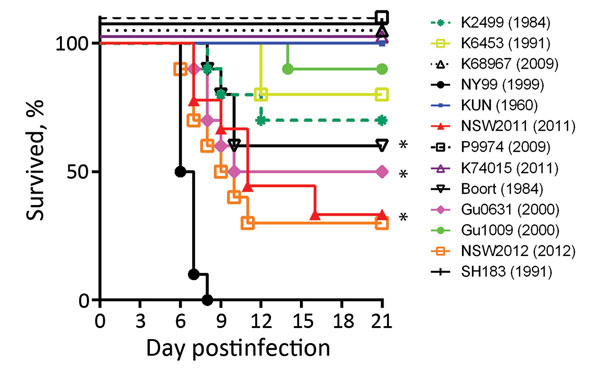Virulence and Evolution of West Nile Virus, Australia, 1960–2012
Natalie A. Prow
12, Judith H. Edmonds
2, David T. Williams, Yin X. Setoh, Helle Bielefeldt-Ohmann, Willy W. Suen, Jody Hobson-Peters, Andrew F. van den Hurk, Alyssa T. Pyke, Sonja Hall-Mendelin, Judith A. Northill, Cheryl A. Johansen, David Warrilow, Jianning Wang, Peter D. Kirkland, Stephen Doggett, Christy C. Andrade
3, Aaron C. Brault, Alexander A. Khromykh
4
, and Roy A. Hall
4
Author affiliations: The University of Queensland, St. Lucia, Queensland, Australia (N.A. Prow, J.H. Edmonds, Y.X. Setoh, H. Bielefeldt-Ohmann, W.W. Suen, J. Hobson-Peters, A.A. Khromykh, R.A. Hall); CSIRO Australian Animal Health Laboratory, Geelong, Victoria, Australia (D.T. Williams, J. Wang); The University of Queensland, Gatton, Queensland, Australia (H. Bielefeldt-Ohmann, W.W. Suen); Department of Health, Brisbane, Queensland, Australia (A.F. van den Hurk, A.T. Pyke, S. Hall-Mendelin, J.A. Northill, D. Warrilow); The University of Western Australia, Nedlands, Western Australia, Australia (C.A. Johansen); Elizabeth Macarthur Agriculture Institute, Menangle, New South Wales, Australia (P.D. Kirkland); University of Sydney and Pathology West–ICPMR, Westmead, New South Wales, Australia (S. Doggett); University of California, Davis, California, USA (C.C. Andrade, A.C. Brault); Centers for Disease Control and Prevention, Fort Collins, Colorado, USA (C.C. Andrade, A.C. Brault)
Main Article
Figure 3

Figure 3. Survival curves for young adult (28-day-old) Swiss outbred mice after intraperitoneal infection with 1,000 PFU of West Nile virus (WNV) strains isolated in Australia, 1960–2012. Groups of 10 mice were infected with each virus. The mice were monitored for 21 days after infection for signs of encephalitis and then euthanized. WNVNY99 and WNVNSW2011 with previously demonstrated virulence were included as controls. The significance of clinical differences between groups was calculated by Kaplan-Meier analysis and analyzed by log-rank test. Significantly increased virulence over that of WNVKUN1960 is indicated by an asterisk (*): WNVBoort (p = 0.0295), WNVGu0631 (p = 0.0115), and WNVNSW2012 (p = 0.0011). No significant differences were observed between WNVBoort, WNVGu0631, and WNVNSW2012 compared with WNVNSW2011 (p>0.05).
Main Article
Page created: July 15, 2016
Page updated: July 15, 2016
Page reviewed: July 15, 2016
The conclusions, findings, and opinions expressed by authors contributing to this journal do not necessarily reflect the official position of the U.S. Department of Health and Human Services, the Public Health Service, the Centers for Disease Control and Prevention, or the authors' affiliated institutions. Use of trade names is for identification only and does not imply endorsement by any of the groups named above.
